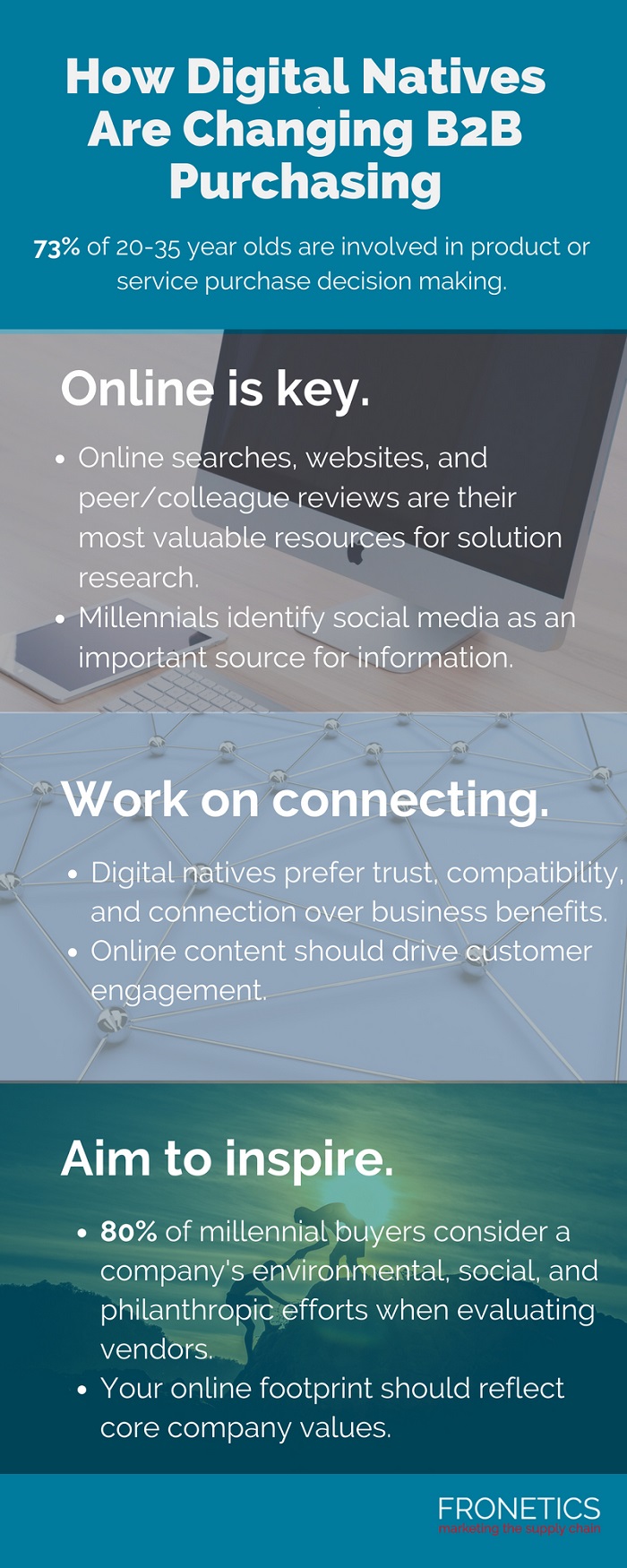
by Fronetics | Sep 6, 2018 | Blog, Content Marketing, Current Events, Logistics, Marketing, Social Media, Strategy, Supply Chain
Digital natives are changing the landscape for B2B purchasing. Here’s what you need to know about the new B2B buyer.
Long gone are the days of men and women sitting around a conference table listening to a sales pitch over a free lunch. Today’s B2B buyers are younger, more technologically savvy, and more independent — they’re a generation of digital natives. And they’re making waves across the B2B buying landscape and changing how marketers must work to reach new customers.
[bctt tweet=”Today’s B2B buyers are younger, more technologically savvy, and more independent — they’re a generation of digital natives. And they’re making waves across the B2B buying landscape and changing how marketers must work to reach new customers.” username=”Fronetics”]
Who are digital natives?
The term digital native describes a person that grows up in the digital age, rather than acquiring familiarity with digital systems as an adult. So, unlike the previous generation, digital natives grew up understanding how to work a computer and a mobile phone instead of picking up these skills (slowly) in our 20s, 30s, or even later.
Having grown up in a time of rapid technological advancement, digital natives are very comfortable online. These skills have carried over to their professional careers, as millennials descend upon the workforce. Organic searches have become the starting point for researching products and services, instead of looking for specific brands.
Ch-ch-changes
This new reality means marketers trying to reach new customers must make big changes in the way they target and engage today’s buyers. Marketers have had to shift their focus from outbound marketing to inbound tactics, like content marketing, to engage and connect with their target audiences.
Here’s what you need to know about digital natives and how their tech-savvy ways have changed the B2B purchasing process.
Infographic: How digital natives are changing B2B purchasing

(Made with Canva)
Final thoughts
With so much content available on the internet, first impressions are everything. Your website needs to be informative and visually pleasing. Your social media posts need to be engaging. Your blog posts need to be enlightening. Make sure your online presence accurately depicts who you are as a brand and what you stand for. Digital natives will be more likely to find and connect with you.
Have digital natives had an impact on your business? Tell us about it.
Related posts:


by Fronetics | Sep 5, 2018 | Blog, Content Marketing, Logistics, Marketing, Strategy, Supply Chain
When your content marketing and sales forces align their efforts, they form a powerful symbiotic relationship that grows your brand and your bottom line.
There’s a big misperception out there that content marketing represents some kind of threat to the job security of sales personnel. It’s absolutely true that content marketing is an inbound approach, contrary to the traditional outbound approach of a B2B sales force. But make no mistake: Content marketing is not a substitute or replacement for an expert sales staff.
[bctt tweet=” It’s absolutely true that content marketing is an inbound approach, contrary to the traditional outbound approach of a B2B sales force. But make no mistake: Content marketing is not a substitute or replacement for an expert sales staff.” username=”Fronetics”]
In fact, it’s when marketing and sales work in tandem that they’re most effective. They can help each other out to generate more leads, nurture current leads more effectively, and even help close more deals.
Content marketing helps generate a steady flow of quality leads, and it provides targeted information to usher prospects down the sales funnel. But even quality leads don’t turn into sales on their own. This is where a sales staff comes in, to take those leads and cultivate them into new business.
Content marketing and sales: Division of labor
For content marketing and sales to work seamlessly together, it’s important to have a clear idea of the role of each. They provide different touch points for leads at each stage of the buying cycle. Here’s a quick primer:
1. Forming a relationship
In this early stage of the buying cycle, your content marketing efforts go toward opening up a dialogue with potential customers. Often, potential leads’ first engagement with your brand comes when they read one of your blog posts, come across your website while searching for product solutions, or see one of your social media posts through their network.
This is when your sales staff picks up the ball, keeping that positive contact going by developing it into a conversation. It’s your sales team’s job to cultivate an ongoing personal relationship with that prospect.
2. Providing information
Now that you’ve established a relationship and your sales team is continuing a dialogue with your prospect, content marketing can step in. B2B buyers report spending more time than ever conducting research, using expert content such as vendor websites, user reviews, and social media before making purchasing decisions. The content that you share with prospects at this stage of the buyer’s journey should be designed to answer informed questions and tip the scales in your favor.
At this stage, your sales staff should be directly answering questions from prospects. When a potential customer reaches out with a query, it’s likely that he or she has done a fair amount of research. So your sales reps need to speak specifically to the customer’s needs in a way that content alone can’t do, to keep them interested and moving down the funnel.
3. Advocating for your brand
Content marketing increases brand awareness for your business. It helps elevate your brand position within the industry and keeps your business top-of-mind, even at a time when potential customers aren’t ready to make a purchase.
When a customer is preparing to make a purchase, your sales staff is the primary advocate for your brand. They should be proactive in pursuing business when customers show interest in your content or when they reach out with questions. They drive dialogue and get to know customers and how your business can help them.
A match made in heaven
When content marketing and sales work together, you’ll see the results hit your bottom line. Curating and creating great content will generate quality leads for your company. And it also empowers your sales force to build relationships with potential customers — and close the sale.
Related posts:


by Fronetics | Sep 4, 2018 | Blog, Content Marketing, Logistics, Marketing, Social Media, Supply Chain
Live video is a powerful tool that can help your supply chain business grow its social media footprint, build brand awareness, and generate leads.
Live video is the super-hot new thing when it comes to generating leads and selling. But the supply chain has, so far, been hesitant to embrace it whole-heartedly as a marketing tool.
I can understand how you might find this new content format too “young” or consumer-facing for B2B sales. But at Fronetics, we think if done right, live video can be really effective.
What is live video?
Maybe you’ve gotten a notification on Facebook to let you know that your nephew is live streaming his piano recital, or a college friend is “live” at a wedding. But, let’s face it: Not many supply chain companies are using live video in their social media marketing. So you may not have thought about it in a professional context.
This “it’ trend in social media has really taken off in the past two years, and marketers are starting to jump on the bandwagon. With today’s emphasis on corporate transparency and putting a real, human face behind business social media accounts, live video is a perfect fit. In fact according to the 2017 Social Media Marketing Industry Report, 61% of marketers plan on using live video services, and 69% are interested in learning more about it.
[bctt tweet=”61% of marketers plan on using live video services, and 69% are interested in learning more about it, according to the 2017 Social Media Marketing Industry Report.” username=”Fronetics”]
These are the 4 live video platforms you should be aware of.
1. Facebook Live
Facebook’s live streaming platform lets you broadcast for up to 90 minutes per session, and notifies your audience that you’re streaming live. It also allows viewers to comment and react during your broadcast, and you can read and respond to their remarks immediately.
2. Periscope
Twitter’s answer to live video, Periscope has more than 10 million users, and lets user live stream from their mobile devices and push those streams directly onto Twitter.
3. Instagram Live
Instagram lets users connect to their followers in real time, through its Stories feature. Like Facebook, Instagram lets viewers add real-time comments that are visible to you and the rest of your audience.
4. YouTube Live
Online streaming video juggernaut YouTube makes it incredibly easy to aim, shoot, and post live video.
How to use live video
Michael Stelzner of Social Media Examiner recently interviewed income strategist and Facebook Live-guru Nicole Walters on the Social Media Marketing Podcast. Walters gave listeners clever tips for using live video to build a following and generate leads. We recommend giving the podcast a listen, but read on for our key takeaways.
Walters advocates for spontaneity in live video but suggests having a format or framework to give you structure and ensure that you’re sticking to your goal of generating leads. Her format is in three parts:
Part One: The Opener
In your introduction, which should be about 30-45 seconds, Walters suggests starting with your name, website, and a brief sentence to give your audience an overview of who your business is and what your video is about. Next, be sure to welcome your audience, perhaps with a special shout-out to new viewers, as well as regulars. Walters also encourages viewers to share her video and to interact with her as she broadcasts.
Part Two: Instructional Content
This is the meat of your video and typically lasts up to 30 minutes. Start by introducing the topic you’re presenting on and why it’s important. Walters also suggests encouraging viewers to take notes, with the rationale that notetaking leads to engaged viewers. If you’re launching a product or service (a great use of live video), you’ll want to cover the need you’re answering with your launch and how your product or service will solve it.
Walters points out that while she prepares extensively for her broadcasts, she avoids reading directly from a piece of paper, as it could easily get impersonal and boring. Instead, she gives herself a cheat-sheet of bullet points to keep her on track.
Part Three: Call-to-Action
This is the final stage of your live video, in which you send your viewers to a page where they can either pay or submit information to receive additional, high-value content (like e-books, webinars, etc.). Walters might say, “If you love this and want to dive in and get the details you need, then head over to NicoleWalters.tv. If you click the center of the page, you’ll find the product… I’ll be right here if you have questions. But come back and tell me you grabbed it.”
Live video offers all kinds of potential value for supply chain marketing. From customer engagement and feedback to transparency and brand awareness, this is a tool for the future of supply chain marketing.
Related posts:


by Jennifer Hart Yim | Aug 30, 2018 | Blog, Leadership, Logistics, Supply Chain, Talent
Bad leadership in procurement has the potential to sink a company’s reputation, making it difficult to hire at all levels below it.
This guest post comes to us from Argentus Supply Chain Recruiting, a boutique recruitment firm specializing in Supply Chain Management and Procurement.
Everyone knows that a bad hire can be really costly to a business. When you account for hiring, training, and onboarding costs, plus the opportunity cost of not hiring a successful employee – not to mention the impact on workplace culture – hiring the wrong person can set a company back tens of thousands of dollars. This is something that people have written about widely across the vast array of blogs about talent.
But what are the costs of hiring the wrong employee (or employees) at the leadership level of a business?
It’s something we’ve been thinking about recently at Argentus. As a firm that helps companies hire at all levels, we have our ears to the ground about the costs that companies bear when leadership issues have hurt their reputations in the marketplace. So particularly in Procurement – one of our core areas of recruitment expertise – what’s the cost of hiring the wrong leadership?
In short, it’s this: a bad hire at the junior level costs lots of money, but a bad hire at the leadership level has the potential to upset the apple cart and sink a company’s reputation, making it difficult to hire at all levels below it. Having the wrong leader in place can create a noxious effect that filters down into senior managers, managers, sole contributors, and junior employees. Procurement sometimes struggles to get buy-in from executives and stakeholders, and having mishandled leadership can make this task even more difficult for everyone in the organization.
Even if it’s a company with a storied history and a powerhouse brand as an employer, word always gets out if the wrong leadership is in place within any specific function. It means that individuals won’t apply for jobs. They won’t respond when recruiters contact them about certain opportunities. At a certain point, it becomes hard to find recruiters who are even willing to help hire for open roles at the company. Given that recruiters, especially those who work on a contingent basis, are usually all over clients trying to send them candidates, if a recruiter won’t work with a company, you know something must be wrong.
As we’ve written about a lot, the marketplace for talent in Procurement and Supply Chain is particularly tight in this strong economy. Companies are battling to bring in star performers who can enact business transformations, implement total cost of ownership models, boost their vendor and risk management, and modernize their Procurement as the function evolves for the future. And if your Procurement leadership develops a negative reputation in the marketplace, attracting those individuals becomes simply impossible.
We should clarify what we mean by bad leadership in Procurement.
We all know it when we’ve seen it, but there are a few traits that ineffective leaders have in common: quite often, they’re individuals tasked with leadership of a Strategic Sourcing organization who don’t have boots on the ground experience in Procurement. They often don’t have the war wounds to understand the function from bottom to top. Strategy and vision are important, but subject matter expertise helps leaders gain credibility with the managers and analysts who are expected to execute that vision.
[bctt tweet=”We all know it when we’ve seen it, but there are a few traits that ineffective leaders have in common: quite often, they’re individuals tasked with leadership of a Strategic Sourcing organization who don’t have boots on the ground experience in Procurement. They often don’t have the war wounds to understand the function from bottom to top. ” username=”Fronetics”]
It’s not absolutely necessary for a CPO or VP of Procurement to have done every job in the function. But if they haven’t, it’s important for them to be able to be humble enough to recognize the subject matter expertise of the people they’re working with – especially if they’re expected to bring changes to the organization. A great leader will admit the gaps in their own knowledge, and work to figure out how they can combine their strengths with those of their team. A bad leader will act like they understand every detail of every Procurement process and category – even if they don’t.
Beyond that, in our experience, the biggest issue with troubled Procurement leadership often comes down to soft skills. For a function that often comes down to negotiation, relationship-building, and getting buy-in, people skills are everything. Ineffective leaders will micromanage, yell, and show a lack of respect for junior employees. How can a leader expect to get buy-in from executives if they can’t build relationships with their own team members? The best leaders in Procurement will empower their teams to pursue cost savings, minimize risk, and increase value without watching them like a hawk.
Leadership is a topic so complex it’s inspired a cottage industry of books and academic research – so we can’t hope to address everything about how to hire effective leaders. But what can companies do to make sure they don’t risk the almost-priceless commodity of their employer brand by installing bad leadership? Be very careful about the leaders that you hire. These individuals should either be subject matter experts, or be very willing to learn from their team-members. When interviewing prospective hires, try to assess their ability to be empathetic and build consensus, and be wary about boasts that they can enact sweeping changes through their force of will alone.
If you can’t, you might be risking more than just the time it took to hire.
Related posts:


by Fronetics | Aug 28, 2018 | Blog, Content Marketing, Logistics, Marketing, Supply Chain
Here are our thoughts on how often your company should blog, including challenges and ways to overcome them.
Creating valuable, relevant content in a strategic and consistent manner creates demand for your products and services and drives profitable customer action. Blogging is a large part of the foundation of your content marketing strategy. If it’s not, it should be.
Blogging is a great way to attract traffic to your website, build brand awareness, and interact with new visitors. But, a question we get all the time is, “How often should my company blog?”
Blogging: frequency matters.
Blogging every once in awhile isn’t going to get you results. You need to publish quality content on a consistent basis to attract prospects to your site.
[bctt tweet=”Blogging every once and awhile isn’t going to get you results. You need to publish quality content on a consistent basis to attract prospects to your site.” username=”Fronetics”]
The reality is that the more often you blog, the more traffic and leads you’ll get. Search engines consider posting frequency in their rankings. What’s more, every time you post, you create a new opportunity to be found, to be shared, and to be linked to by other sites.
Blogging: the challenge.
The trouble in publishing more posts is balancing resources so that you’re publishing frequently but maintaining value and quality within your content. We’re big advocates of testing to find your personal sweet spot for the amount of posts your organization is able to publish to maximize traffic and leads.
When you start publishing more frequently, make sure to track your KPIs, calculate ROI, and assess whether increasing blogging frequency is right for your business. You may be surprised at the results.
Here’s Elizabeth Hines, creative/editorial director at Fronetics, to discuss how often your company should be posting blogs.
Video: How often should my company blog?
Final thoughts.
Blogging needs to be a central part of your content marketing strategy. And unfortunately, it can take a while to start drawing traffic (and eventually, leads) from your posts. But the benefits of consistent blogging make it worth it.
And don’t forget, blog posts become more credible with age. That is to say, search engines value older content that has had more time to accumulate, like social shares and referrals from other web pages. The more relevant a blog post proves itself to be to readers over time, the higher it will rank in search engine results.
Have you tried blogging more frequently? Coming up with topics can be one of the biggest challenges. But don’t worry, we’ve got you covered.
Related posts:


by Fronetics | Aug 27, 2018 | Blog, Content Marketing, Logistics, Marketing, Social Media, Strategy, Supply Chain
Repurposed and repackaged, your existing content is a valuable asset for your sales force throughout the buyer’s journey.
If you’re a supply chain marketing professional, it’s likely that you spend a tremendous portion of your day researching, creating, packaging, and disseminating content. Your hard work is all about growing brand awareness and building your reputation as a trusted industry thought-leader — all with the goal of having that work eventually convert leads.
But, consider this: When it comes to engaging prospects and clients, only 20% of salespeople actually use content. When we know that potential buyers are far more willing to engage with someone offering them information and insight, why are B2B businesses abandoning content as soon as prospects are handed over to sales?
B2B buyers prefer content throughout the buying journey
According to DemandGen’s 2018 Content Preferences Survey Report, “Buyers are becoming increasingly more selective in the content they are consuming,” relying more on “trustworthy sources, industry influencers, and their peers to educate themselves.” And furthermore, 88% of those survey respondents want less focus on product specifics and more on the value that product can bring to their business.
[bctt tweet=”Buyers are becoming increasingly more selective in the content they are consuming, relying more on trustworthy sources, industry influencers, and their peers to educate themselves.” username=”Fronetics”]
And on the other side of that coin, according to HubSpot writer and marketing expert Bethany Cartwright, sales reps spend about 15% of their day leaving voicemails, and only about 20% of all sales emails are ever opened. “This means 80-85% of sales outreach efforts are going unnoticed by those prospects you’ve worked so hard to capture with content,” writes Cartwright.
It’s time to start leveraging your content throughout the buyer’s journey by arming your sales force with content. Before you panic at the idea of creating reams of new content, take a breath. It’s more than likely that you can repurpose your existing content, optimized to give your sales force the tools they need to close deals.
So how do you go about repurposing your content and giving your sales force the best possible tools with which to convert prospects to buyers? Web Profits co-founder and author Sujan Patel suggests “mapping content generated by your marketing team to each stage of your customer’s buying journey.” We’ve created the infographic below to help you optimize content for each of the three stages of the buyer’s journey.
Infographic: Delivering content throughout the buyer’s journey

(Made with Canva)
Related posts:













